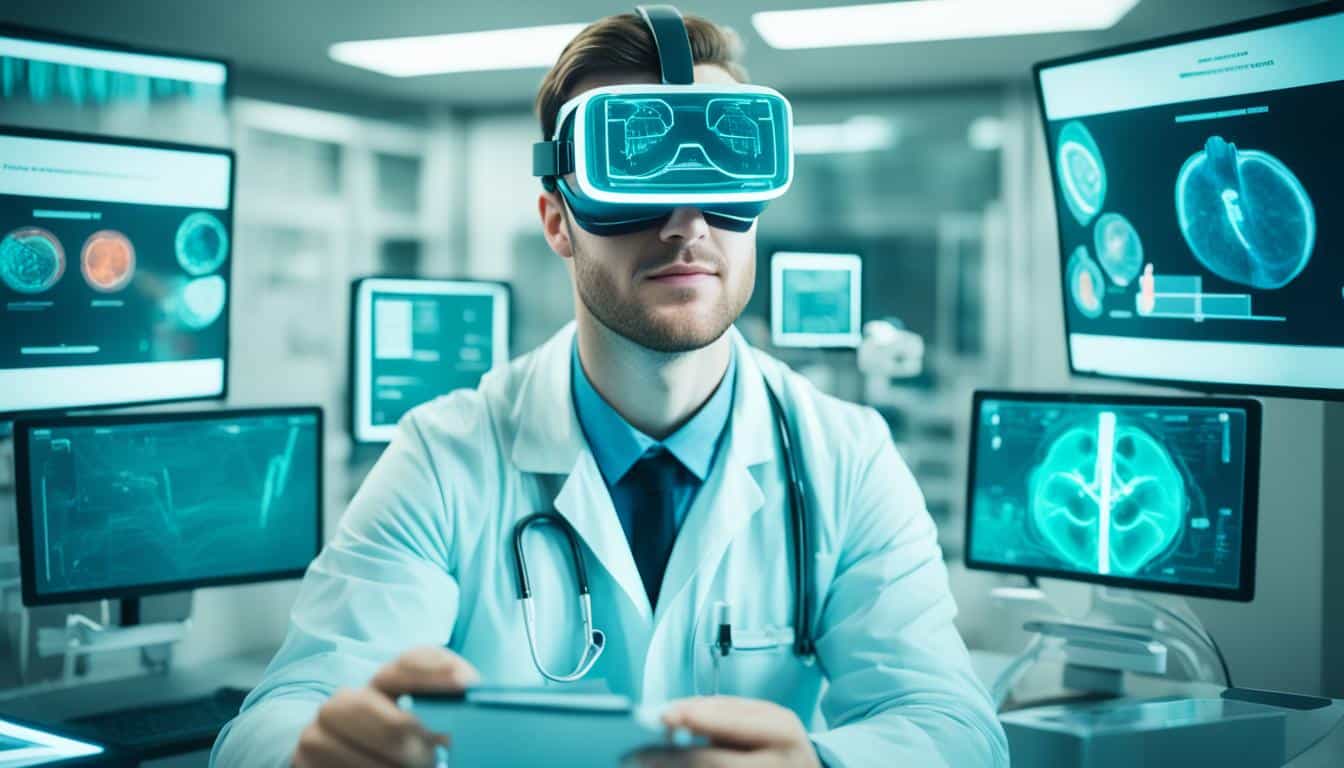Table of Contents
ToggleMedical education is changing fast, thanks to various forces. These include the evolving healthcare world, new social needs, and medical science progress. With the physician’s role and training methods changing, the impact of technology is huge. It’s set to change how students learn, make decisions, and see things differently.
Technology changes medical education in many ways. It helps students learn, improves their skills, and how they work in teams. It not only changes how learning happens but also deals with old training ways not meeting patient safety needs. The traditional “see one, do one, teach one” method is no longer enough.
Key Takeaways
- Medical education is rapidly changing, influenced by shifts in health care, society, and medical science.
- Technology is a major player, changing how students learn and develop key skills.
- It aims to boost learning, improve problem-solving, and change how students see things.
- These changes address ethical problems and make sure patient safety is top priority.
- New curriculum and ways of learning are being created for the next healthcare professionals.
Challenges Driving the Use of Technology in Medical Education
Technology is changing how we learn in the medical field. The way we teach and care for patients is evolving. This change comes from different places. These include the changing world of healthcare and what the public expects. Plus, there’s a big focus on making sure patients stay safe. All this is mixing together with technology in the classroom.
Changing Healthcare Environment
How and where we get healthcare is changing. It’s moving from just hospitals to where people normally receive care, like clinics or their own homes. This means students need to learn how to use digital tools for their future careers.
Evolving Societal Expectations
People now want more insight, truthfulness, and safety in their healthcare. It’s making us rethink how we train new doctors. We’re finding ways to use tech in training that don’t compromise patient rights.
Emphasis on Patient Safety
Putting patient safety first is now a key goal for those teaching medicine. It’s not just about knowing facts – students need to act safely and smartly. Technology like simulations and virtual learning play a big role in this new approach to training.
The world of medical education is moving fast. Technology is a big part of the solution. It’s helping students and teachers face today’s and tomorrow’s challenges together.
Educational Goals of Technology in Medical Education

Technology in medical education has several important aims. This includes making it easier to learn, think better, and see things from different views.
Facilitating Knowledge Acquisition
Using tech tools helps medical students and residents learn a lot more efficiently. They get to use cool stuff like digital anatomy models. This makes learning more fun and personal than just reading a book.
Improving Decision-Making Skills
Being able to make good decisions as a doctor is crucial. Tech helps with this through simulated cases and games. It lets future doctors practice and improve without risks to patients.
Enhancing Perceptual Variation
Every human body and illness look different. Tech shows these differences to medical students better. This helps them become better at figuring out what’s wrong and giving special care. Taking advantage of tech abilities, educators can change how students learn. It makes learning together and on a personal level possible. This means we get doctors and care teams that are ready to use the best knowledge for their patients.
Also Read : Financial Jobs: How Does Technology Impact The Field?
Computer-Assisted Learning and Flipped Classrooms

The world of medical education is changing a lot. It’s starting to use computer-assisted learning and the flipped classroom way of teaching. These new methods are making it better for medical students to learn. The flipped classroom turns the old way of teaching upside down. Students study the lesson, often through streaming videos, before class. Then, the classroom time is for interacting with the teacher and doing activities that let them use what they’ve learned.
Studies have found this new way helps students get more into their studies, feel better about learning, and learn more. Rather than just listening, students are actively involved. This makes them understand the subjects better.
“The flipped classroom model empowers students to take a more active role in their learning, leading to increased satisfaction and better knowledge retention.”
Using computer-assisted learning is also becoming very important in medical education. These tools provide custom feedback, simulations, and online resources. They’re made to fit each student’s needs, helping them learn faster. When medical teachers mix computer-assisted learning with the flipped classroom model, it makes learning more fun and useful. It meets the modern, digital learning goals of today’s students.
Also Read : Nursing Education: Why Choose A Science Degree?
Mobile Devices and Medical Apps
Medical education is changing fast thanks to mobile devices and medical apps. Technologies like smartphones and tablets are transforming how future doctors learn. They make it easier to study, handle patient data, and decide on treatments.
Personal Digital Assistants (PDAs)
PDAs are key tools for both students and doctors. They’re small devices that help access medical info and calculate doses. With a PDA, students can find answers fast and make smart choices about patients’ health.
Smartphone and Tablet Apps
Smartphones and tablets have brought in a flood of medical apps. Many focus on basic medical concepts, and more are helping with real-world diagnoses and treatments. Websites like iMedicalApps.com are great for finding the best apps. Stanford University is also in on the tech trend, offering its own medical apps. These cover everything from making clinical decisions to teaching patients.
This tech isn’t just making learning easier. It’s improving how patient care is managed, treatments are chosen, and decisions are made.
Digital Games for Medical Training

Digital games are becoming popular for training doctors. These games are not just for fun but for serious learning too. They offer challenges that help future surgeons gets better at what they do. Serious games for surgical training make a big difference. They improve how fast a doctor’s hands and mind work together. This skill is key for successful surgeries.
Serious Games for Surgical Training
Serious games help doctors learn how to do surgeries. They provide a safe place for practice. This means less risk for real patients. Doctors get to improve their surgery skills without worrying about hurting anyone. They get better at making quick choices, their hand movements, and how they do surgeries.
Role-Playing Games for Geriatric Education
Digital games are also used to teach about older people’s needs. At the Florida State University, students learn this with a game called ElderQuest. In ElderQuest, they must care for a sick wizard. This game helps students understand and care about the elderly more.
Using digital games in medical school is a new but good thing. It helps students learn both the tech side and the people skills of being a doctor or nurse. These games are fun and teach well. They might change how we train future doctors and nurses for the better. This can lead to better health care for all.
Also Read : PHD Education: Can I Work During A PHD?
| Game Type | Educational Objectives | Target Audience |
|---|---|---|
| Serious Games | Develop surgical skills, improve eye-hand coordination and reflex times | Medical students, residents |
| Role-Playing Games | Enhance understanding of geriatric population and their unique needs | Medical students in geriatric clerkships |
Simulation Technologies in Medical Education
Simulation technologies are now key in teaching medicine. These tools mimic real clinical situations. They help medical students improve their skills and make better choices in a risk-free setting. From models of body parts to sophisticated patient simulators, these methods have many educational benefits.
Spectrum of Simulation Techniques
Simulation use in medical training is varied, meeting different goals and skills. At the start, students use mannequins like Rescusi Anne to learn CPR. As they advance, they work on complex cases with fake patients or computer avatars. This helps develop a wide array of clinical abilities.
High-Fidelity Medical Simulations
High-tech simulation tools mimic full human physiology. They can react to treatments medical schools in the united in real time. Tools like the Harvey cardiology simulator give detailed practice, postgraduate medical immediate feedback, and let students repeat tasks to get better. Research shows these simulations really improve how medical students learn and help keep patients safe.
| Simulation Technique | Educational Benefits |
|---|---|
| Anatomical Models | Developing procedural skills, understanding anatomy |
| Standardized Patients | Enhancing communication, history-taking, and decision-making |
| High-Fidelity Simulators | Providing realistic feedback, enabling repetitive practice, and capturing clinical variation |
“The weight of the best available evidence suggests that high-fidelity medical simulations facilitate learning under the right conditions.”
– Issenberg et al., Systematic Review
Virtual Reality and Augmented Reality in Healthcare Education
The healthcare world is changing with new tech like virtual reality (VR) and augmented reality (AR). These technologies are medical degree leading a big shift in how we teach degree programs healthcare. They give students and pros new ways medical curriculum to learn and train better. With VR and AR, teachers can make simulations that feel real. Students get to practice making tough choices, do procedures, and really understand what patients go through. And they can do it all safely, without risking patients.
Take VR for example. It can show what living with illnesses or pain feels like. This helps doctors and nurses connect more with what patients deal with. Similarly, AR can aid in preparing for surgeries. It lets doctors see and work with 3D organs before the surgery. This makes them more precise and ready, even before the operation starts.
Elara is one company paving the way in VR and AR for healthcare learning. They make these high-tech tools that boost how medical pros learn and make basic science decisions. Their work is changing the game in healthcare training.
“Virtual reality and augmented reality are transforming the way we approach healthcare education, allowing students and professionals to gain hands-on experience in a safe, immersive environment.”
The world needs more skilled healthcare workers every day. Using medical and health VR and AR in health professions medical school is becoming really important. It helps get future doctors and nurses basic science ready to face the program degree programs directors challenges of tomorrow.
Also Read : Educational Psychology: How Does It Impact Student Learning?
Wearable Technologies for Healthcare Learners
The healthcare industry is always growing. Now, wearable devices are a big part of education research learning in the medical field. These new gadgets let healthcare students better their health science skills and care for patients in smarter ways.
Google Glass in the Classroom
Google Glass is changing how students learn in medical schools. At the University of residency program medical school Washington (UW) and others, it’s giving a new look at surgeries and exams. This tech professional development shares the doctor’s view live, helping students see procedures up close and personal.
Wearable Devices for Patient Monitoring
Devices that monitor patients are also key in teaching healthcare students. They can graduate medical education school of medicine follow vital signs and how active someone is, plus other health numbers. Medical students get a chance to residency program practice working with “patients” who wear these devices. Their teachers then see how they perform, like if they’re caring and pay attention when they talk or react during visits.
The info from these wearables teaches a lot about how students are learning. This helps trainers adjust what they teach, making sure the future doctors and nurses get it right. By using wearables, schools are passing new care skills on to budding healthcare providers. They learn to be kinder and focus on the patient’s needs.
“Wearable technologies are changing medical learning, offering fresh views and key data to make healthcare education better for students.”
Also Read : Which Education And Training Are Required For Medical Jobs?
As tech keeps getting better, so will the ways it helps medical students. Wearable gadgets will soon be everywhere in med schools. They’re tools for students to get better at their jobs and take excellent care of patients.
Medical Education

The way students learn in medical education is being changed by new technology. This tech helps students better understand and make decisions. It also gives them a different way to see things. Technology makes learning in medical education easy and flexible. Computer-assisted learning and flipped classrooms let students learn at their speed. This makes learning better for students. Mobile devices and medical apps let students learn anywhere. This lets students work together better.
There have been big improvements in how students practice through simulation-based training. Things like digital games and Medical simulations make learning safe. The use of virtual reality and augmented reality take learning to new levels. Technology in medical education will keep growing. This will change how healthcare is done. New tech like wearable technologies and Google Glass join learning and tech together.
In the future, teamwork between healthcare professionals will be really important. Everyone working together will help patients more. Technology makes it easier for teams to share information. Medical education will keep getting better with technology’s help. This sparks new ideas and ways to care for patients.
| Technology in Medical Education | Benefits |
|---|---|
| Computer-Assisted Learning and Flipped Classrooms | Accessible and convenient learning opportunities |
| Mobile Devices and Medical Apps | On-the-go access to information and resources |
| Simulation Technologies | Safe and controlled environment for skill development |
| Virtual Reality and Augmented Reality | Unprecedented levels of immersion and experiential learning |
| Wearable Technologies | Integration of technology and medical pedagogy |
“As technology continues to evolve, medical education will adapt and leverage these advancements, shaping the future of healthcare and producing a new generation of competent and tech-savvy healthcare professionals.”
Also Read: Education Degree Online: What Are The Admission Requirements?
Conclusion
Technology has changed how future healthcare workers learn. It offers tools like virtual reality and online learning. These have become key in medical education’s evolution.
This change has made learning easier and deeper. Students can now understand complex topics better. They learn more by working together and using the latest tech tools, fitting their own needs.
The need for tech in medical education will keep growing. New solutions will keep coming. This means future healthcare workers will be better trained, ready to care for patients, and shape the healthcare world.
FAQs
1. How has technology improved medical education?
Technology has enhanced medical education by providing interactive learning tools such as virtual simulations, 3D anatomy models, and artificial intelligence (AI)-powered tutoring. These innovations help students grasp complex medical concepts more effectively and improve their diagnostic skills.
2. What role does virtual reality (VR) play in medical training?
VR allows medical students to practice surgical procedures, diagnose diseases, and explore human anatomy in a risk-free, immersive environment. This hands-on experience enhances learning without the need for actual patients.
3. How does artificial intelligence (AI) assist in medical education?
AI provides personalized learning experiences by analyzing students’ progress and adapting coursework to their needs. AI-powered chatbots and virtual assistants also help answer medical queries and support self-paced learning.
4. What are the benefits of online learning platforms in medical education?
Online platforms enable students to access medical lectures, case studies, and research materials from anywhere in the world. They also facilitate collaboration between medical professionals through webinars and discussion forums.
5. Are there any challenges associated with using technology in medical education?
Yes, some challenges include high implementation costs, the need for continuous updates, and concerns about data security. Additionally, over-reliance on technology may reduce hands-on clinical exposure, which is crucial for medical training.





